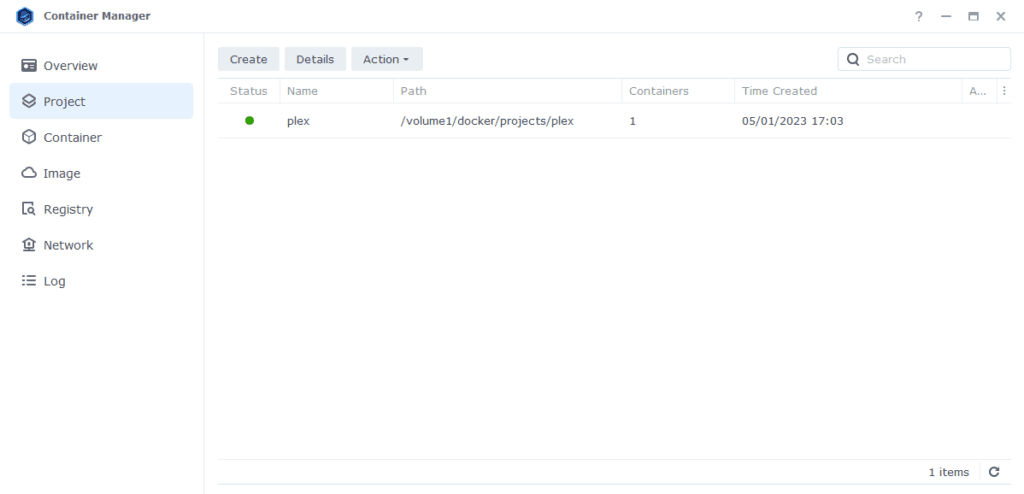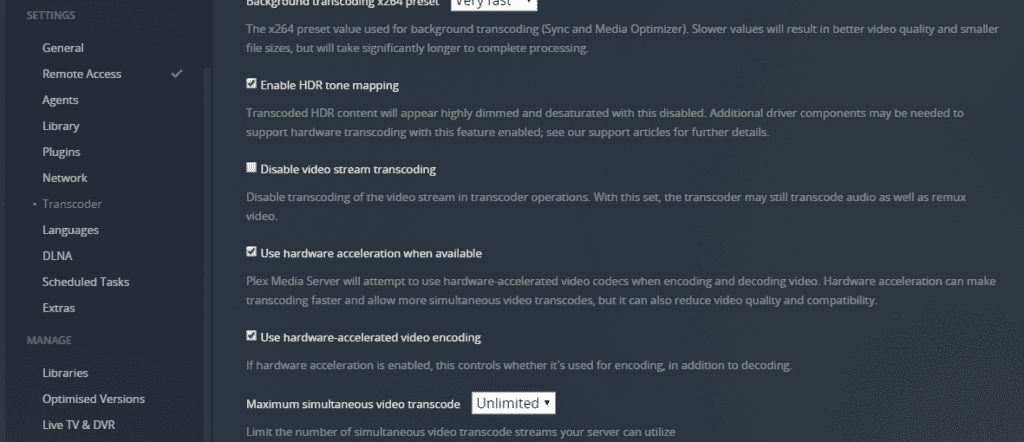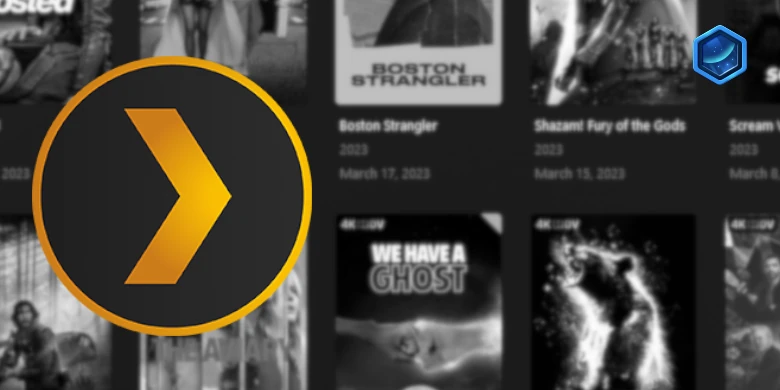Last updated on 30 July 2025
Important or Recent Updates
| Historic Updates | Date |
|---|---|
| New DSM7.2 Container Manager Update | 01/05/2023 |
| Added additional security option to the compose to restrict the container from gaining new privileges as well as umask variable | 25/10/2023 |
| Somehow at some point a paragraph about forwarding port 32400 went missing, I had never added it! But it’s in now!! | 13/06/2024 |
| Changed ‘version’ variable to ‘docker’ this will stop in container server updates! | 01/07/2024 |
In this guide I am going to take you through the setup of Plex in Docker using Container Manager.
Plex Pass
You will only benefit from hardware transcoding if you have an active Plex Pass either monthly or lifetime. If you don’t have one you can either follow this guide or jump over to the non hardware transcoding version.
Does my Synology support Hardware Transcoding?
Before we do anything else, you need to make sure your model of Synology has hardware transcoding capabilities. You need to do a quick lookup via the linked Google Sheet below, this is updated by Plex and makes it super easy to look up your model of NAS.
If you find that hardware transcoding is not available on your model you can jump back over to the standard guide on the menu.
Let’s Begin
As usual, it’s important you complete the two proceeding guides which will get your folder structure and docker, user setup.
Folder Setup
Let’s start by getting some folders set up for the container to use. Open up File Station create the following.
/docker/projects/plex-compose
/docker/plex
Container Manager
Next we are going to set up a ‘Project’ in Container Manager. Open up Container Manager and click on Project then on the right-hand side click ‘Create’.

In the next screen we will set up our General Settings, enter the following:
| Section | Setting |
|---|---|
| Project Name: | plex |
| Path: | /docker/projects/plex-compose |
| Source: | Create docker-compose.yml |
Next we are going to drop in our docker compose configuration copy all the code in the box below and paste it into line ‘1’ just like the screenshot.

services:
plex:
image: linuxserver/plex:latest
container_name: plex
network_mode: host
environment:
- PUID=1234 #CHANGE_TO_YOUR_UID
- PGID=65432 #CHANGE_TO_YOUR_GID
- TZ=Europe/London #CHANGE_TO_YOUR_TZ
- UMASK=022
- VERSION=docker
- PLEX_CLAIM= #Your Plex Claim Code
volumes:
- /volume1/docker/plex:/config
- /volume1/data/media:/data/media
devices:
- /dev/dri:/dev/dri
security_opt:
- no-new-privileges:true
restart: alwaysA note on Network Mode
You will notice that for Plex we don’t put it on the normal bridge network, this is because DSM reserves the DLNA ports Plex requires in order to use DLNA. So we run in Host mode, so it can share the ports.
Environment Variables
We need to make some changes in order for the container to have the correct permissions to save its configuration files and to have access to your media.
| Variable | Value |
|---|---|
| PUID | (required) The UID you obtained in the user setup guide |
| PGID | (required) The GID you obtained in the user setup guide |
| TZ | (required) Your timezone wikipedia.org/wiki/List_of_tz_database_time_zones |
| PLEX_CLAIM | Please note the PLEX_CLAIM variable is optional and not always required. You can remove this line if you don’t need it or come back and add it if you are unable to sign in to your server on start up. To get the code go to https://plex.tv/claim and sign in, then put the code you receive after the ‘PLEX_CLAIM=’. You have 4 mins to finish the guide after doing this, so best to grab it just before running the project. |
Volumes
I have pre-filled this section to pass the correct paths, the only thing that you may need to change is the /volume1/ if your file paths are on a different volume.
Click ‘Next’
You do not need to enable anything on the ‘Web portal settings’ screen click ‘Next’ again.

On the final screen click ‘Done’ which will begin the download of the container images and once downloaded they will be launched!

The image will now be downloaded and extracted. You should see ‘Code 0’ when it has finished.

You will now see your Plex running and should have a green status on the left-hand side.

Firewall Exceptions
(Skip if you don’t have the Firewall configured)
If you have the Synology Firewall enabled please see this additional guide for further info on exceptions and correct set up.
Port Forwarding
In order to use Plex remotely and stream your local media you need to forward port 32400 from your Router to the NAS IP on the same port. This varies for everyone’s router so check the manual on how to do this.
Plex Initial Setup
After a few minutes you should be able to access the server and go through the Plex setup by going to the IP of your NAS in your browser followed by port 32400/web/
e.g. 192.168.0.45:32400/web/
You will be asked to sign in or sign up for an account if you don’t have one already.

You should now be able to add your media which will be in the /data/media folder within Plex

Once you have got to the main Plex interface make sure you go into the settings and turn on
- Enable HDR tone mapping
- Use hardware acceleration when available
- Use hardware-accelerated video encoding

That’s it you are all setup. When a new server update is available you will just need to restart the container, and it will automatically download the latest update.
Looking for some help, join our Discord community
If you are struggling with any steps in the guides or looking to branch out into other containers join our Discord community!
Buy me a beverage!
If you have found my site useful please consider pinging me a tip as it helps cover the cost of running things or just lets me stay hydrated. Plus 10% goes to the devs of the apps I do guides for every year.




Is there a way to have the plex metadata cache moved to an NVME but keep all the data still on the HDD through your method? Trying to speed up the scrolling with multiple users. Thanks for the guide!
100% – A ton of us on Discord do the same, we have NVME volumes setup.
Migrate the whole /docker share over to the NVME volume (scripts below) and ideally the Container Manager Package then this will be /volume2 and the data will remain on /volume1
https://github.com/007revad/Synology_enable_M2_volume
https://github.com/007revad/Synology_HDD_db
https://github.com/007revad/Synology_app_mover
Fantastic, thank you. I had seen these, but as I’m kind of an idiot, I wasn’t sure if it would mess with the script that you already had written up somehow. I’ll give it a whirl and hope for the best! I appreciate this whole guide, still working my way to the end but if I can make it then anyone can.
When I move the docker share file from volume 1 to volume 2, it breaks all the projects except watchtower. I’ve tried going in to the yaml and changing to volume 2 for the config path, but no success. get a daemon: container string error. Do I need to start from scratch on volume 2? Thanks
Never mind, sorry! Found the info I needed in the discord!
Getting this error when startingthe project
‘plex docker synology error gathering device information while adding custom device “/dev/dri”: not a device node’
any ideas?
Hey sounds like you are using a NAS that is not using an Intel CPU. What model do you have?
thansk for quick response – you’re right. I’d managed to troubleshoot the issue but now not convinced the upgrade from 718+ to 723+ will be worth my time/money
found issue – my DS723+ doesn’t have HW transcoding which is a bit of a pain, not sure how badly that’s going to affect me at the moment. May end up sticking with my trusty 718+
Ahh makes sense – locally most devices will direct play so shouldn’t be an issue – it will be more if you stream when away from home or have other users you need to limit upload speeds to..
Hi, How can we install plugins with docker plex?
For example the plugin for tube archivist: https://github.com/tubearchivist/tubearchivist-plex
Hey I have this set up. Essentially in the /docker/plex/Library/Application Support/Plex Media Server is where all the files as described in the installation steps. You need to follow them exactly and in order to make sure you put the files in the right places.
I just wanne thank you. you have the best guides I could find. That includes great file mapping and work with yaml instead of Portainer. I have learned a lot of you.
No problem, glad they are useful 🙂
I’ve been fighting with “slow response time” when attempting to access my 920+, thought no CPU constraints were being shown. Finally noticed the reported upstream data was consistently 2-300K more than I would have expected, which combined with other things put me pretty closed to a saturated uplink.
Playing a hunch, (and after backing up the plex app data folder), I rolled back to 1.40.3.8555-fef15d30c-ls221 (from the latest which is 1.40.4.8679-424562606-ls222), and everything seems to have settled down.
Wow, I wish I’d found Dr Frank BEFORE that whole “geminilake hardware transcoding broken for MONTHS/multiple versions” debacle.
I have started locking into known working versions on some containers as sometimes being on the bleeding edge comes with issues. They key is not to leave it too long between updates if fixing in a version number 🙂
possible false alarm. further reading indicated some of the new functionality required a meta data refresh, so I re-upgraded and forced a meta refresh, and everything seems to be behaving now.